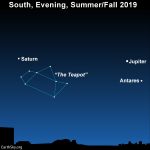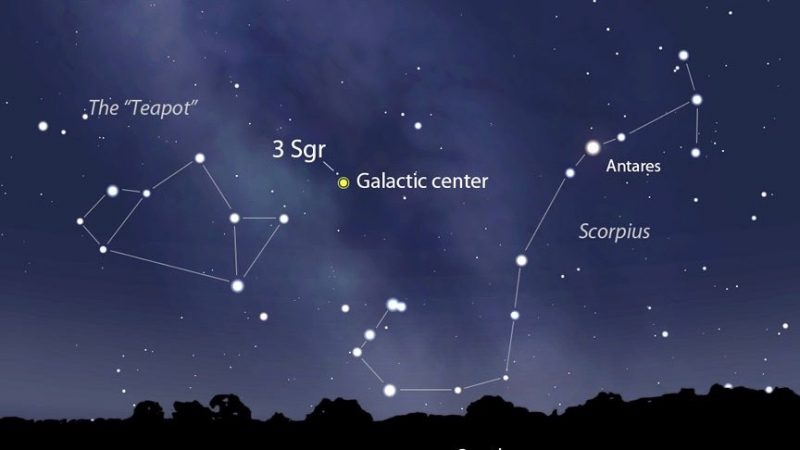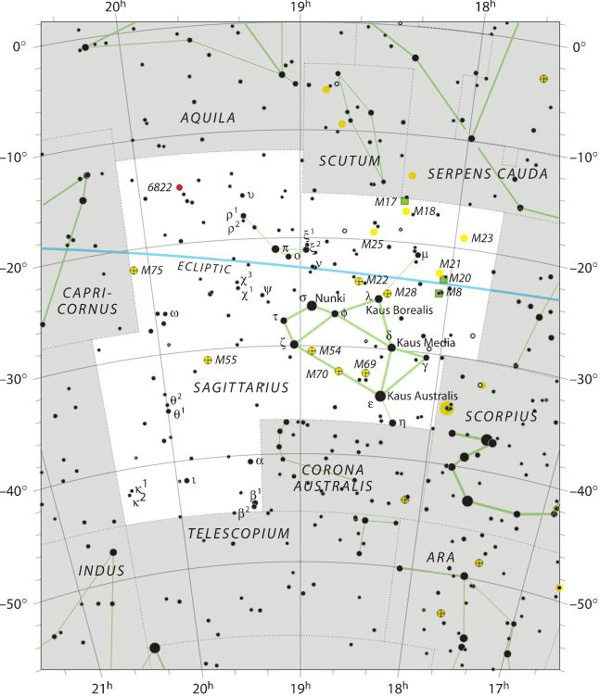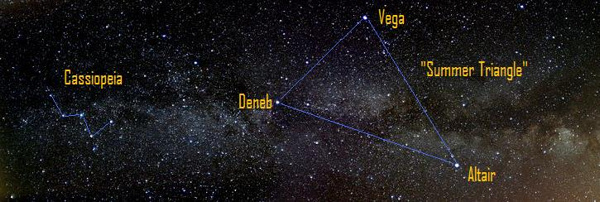
Tonight, or on any moonless evening during a Northern Hemisphere summer or Southern Hemisphere winter, you can look in the evening hours toward the center of our Milky Way galaxy. It’s located in the direction of the constellation Sagittarius the Archer, which happens to contain a famous asterism – or noticeable pattern of stars – called the Teapot.
From the Northern Hemisphere, you’ll be looking south during the evening hours for this star pattern. From the Southern Hemisphere, look for the Teapot to climb high overhead around mid-to-late evening.
If you’re blessed with a dark sky, finding all this will be easy. In a dark sky, you’ll see a broad boulevard of stars – the edgewise view into our own Milky Way galaxy – which broadens and brightens in the direction of the galaxy’s center.
Or maybe you know the planets? If you have that dark sky, know that, in 2019, the Teapot is found in between between two bright planets, Saturn to the east and Jupiter to the west. Jupiter is by far the brighter of these two worlds. In fact, it’s the 4th-brightest celestial object to light up the sky, after the sun, moon and the planet Venus. But Venus is now lost in the sun’s glare, so there’s no mistaking Venus for Jupiter in the August 2019 night sky.
Don’t know the planets and don’t have a dark sky? The chart below via AstroBob expands the view to include the constellation Scorpius, which is relatively bright and easy to spot for its curved Scorpion’s Tail. Sagittarius the Archer – and its Teapot asterism – is next door to Scorpius on the sky’s dome.

From the Northern Hemisphere, look southward August and September evenings to see these stars. From the Southern Hemisphere, look generally overhead or northward, higher in the sky and turn this chart upside down. Chart via AstroBob.
We can’t really see the galactic center. It’s heavily veiled by intervening stars, star clusters and nebulae (vast clouds of gas and dust). The center of our Milky Way looms some 26,000 light-years away. But we can gaze toward this direction in space, and – if your sky is dark enough – it’s a sight to behold!
By the way, the Teapot makes up the western half of the constellation Sagittarius the Archer. Modern eyes have an easier time envisioning a teapot than an Archer with a drawn-out bow. See the sky chart of Sagittarius below.

View larger. | The constellation Sagittarius, with the Teapot asterism outlined in green.
From temperate latitudes in the Northern Hemisphere, it’s pretty easy to make out the Summer Triangle asterism rather high in the eastern sky at nightfall. This huge star formation consists of three brilliant stars – Vega, Deneb and Altair – and can oftentimes withstand the glare of the full moon or light-polluted city.

View larger. | Great rift of Milky Way passes through the constellation Cassiopeia and the Summer Triangle. Draw an imaginary line from Deneb through Altair, going about twice the Deneb-Altair distance, to star-hop to the Teapot of Sagittarius
If you are otherwise lost on some starry night but can find the Summer Triangle, let this signpost star formation escort you to the Teapot …
Bottom line: Blessed with a dark sky? Try finding the Teapot in Sagittarius.
Read more: Sagittarius? Here’s your constellation
from EarthSky https://ift.tt/2lSmrMp

Tonight, or on any moonless evening during a Northern Hemisphere summer or Southern Hemisphere winter, you can look in the evening hours toward the center of our Milky Way galaxy. It’s located in the direction of the constellation Sagittarius the Archer, which happens to contain a famous asterism – or noticeable pattern of stars – called the Teapot.
From the Northern Hemisphere, you’ll be looking south during the evening hours for this star pattern. From the Southern Hemisphere, look for the Teapot to climb high overhead around mid-to-late evening.
If you’re blessed with a dark sky, finding all this will be easy. In a dark sky, you’ll see a broad boulevard of stars – the edgewise view into our own Milky Way galaxy – which broadens and brightens in the direction of the galaxy’s center.
Or maybe you know the planets? If you have that dark sky, know that, in 2019, the Teapot is found in between between two bright planets, Saturn to the east and Jupiter to the west. Jupiter is by far the brighter of these two worlds. In fact, it’s the 4th-brightest celestial object to light up the sky, after the sun, moon and the planet Venus. But Venus is now lost in the sun’s glare, so there’s no mistaking Venus for Jupiter in the August 2019 night sky.
Don’t know the planets and don’t have a dark sky? The chart below via AstroBob expands the view to include the constellation Scorpius, which is relatively bright and easy to spot for its curved Scorpion’s Tail. Sagittarius the Archer – and its Teapot asterism – is next door to Scorpius on the sky’s dome.

From the Northern Hemisphere, look southward August and September evenings to see these stars. From the Southern Hemisphere, look generally overhead or northward, higher in the sky and turn this chart upside down. Chart via AstroBob.
We can’t really see the galactic center. It’s heavily veiled by intervening stars, star clusters and nebulae (vast clouds of gas and dust). The center of our Milky Way looms some 26,000 light-years away. But we can gaze toward this direction in space, and – if your sky is dark enough – it’s a sight to behold!
By the way, the Teapot makes up the western half of the constellation Sagittarius the Archer. Modern eyes have an easier time envisioning a teapot than an Archer with a drawn-out bow. See the sky chart of Sagittarius below.

View larger. | The constellation Sagittarius, with the Teapot asterism outlined in green.
From temperate latitudes in the Northern Hemisphere, it’s pretty easy to make out the Summer Triangle asterism rather high in the eastern sky at nightfall. This huge star formation consists of three brilliant stars – Vega, Deneb and Altair – and can oftentimes withstand the glare of the full moon or light-polluted city.

View larger. | Great rift of Milky Way passes through the constellation Cassiopeia and the Summer Triangle. Draw an imaginary line from Deneb through Altair, going about twice the Deneb-Altair distance, to star-hop to the Teapot of Sagittarius
If you are otherwise lost on some starry night but can find the Summer Triangle, let this signpost star formation escort you to the Teapot …
Bottom line: Blessed with a dark sky? Try finding the Teapot in Sagittarius.
Read more: Sagittarius? Here’s your constellation
from EarthSky https://ift.tt/2lSmrMp

Aucun commentaire:
Enregistrer un commentaire